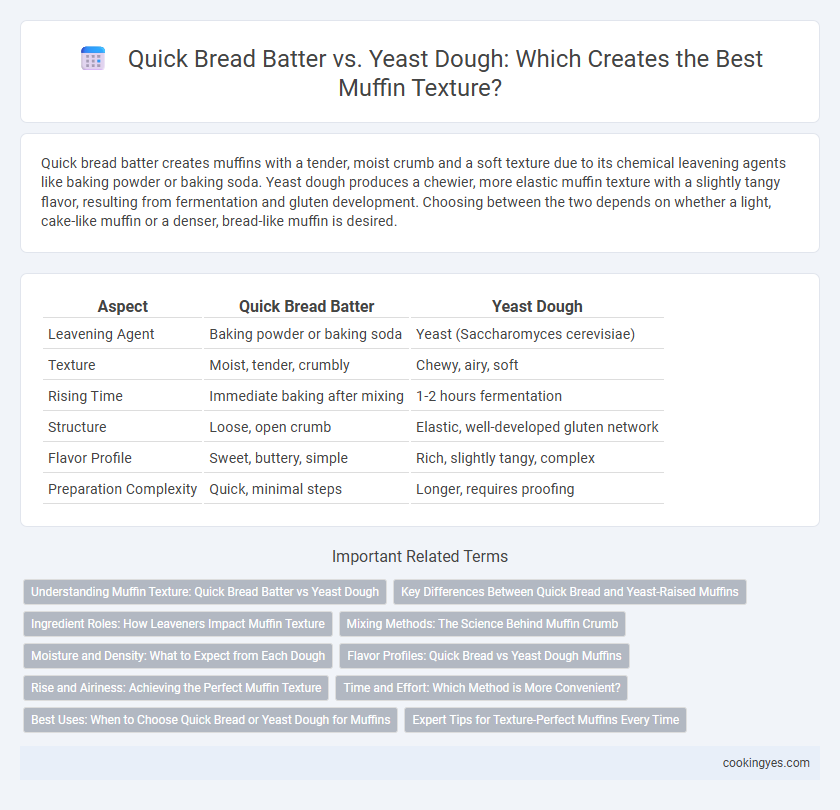Quick bread batter creates muffins with a tender, moist crumb and a soft texture due to its chemical leavening agents like baking powder or baking soda. Yeast dough produces a chewier, more elastic muffin texture with a slightly tangy flavor, resulting from fermentation and gluten development. Choosing between the two depends on whether a light, cake-like muffin or a denser, bread-like muffin is desired.
Table of Comparison
| Aspect | Quick Bread Batter | Yeast Dough |
|---|---|---|
| Leavening Agent | Baking powder or baking soda | Yeast (Saccharomyces cerevisiae) |
| Texture | Moist, tender, crumbly | Chewy, airy, soft |
| Rising Time | Immediate baking after mixing | 1-2 hours fermentation |
| Structure | Loose, open crumb | Elastic, well-developed gluten network |
| Flavor Profile | Sweet, buttery, simple | Rich, slightly tangy, complex |
| Preparation Complexity | Quick, minimal steps | Longer, requires proofing |
Understanding Muffin Texture: Quick Bread Batter vs Yeast Dough
Quick bread batter for muffins creates a tender, moist crumb due to chemical leaveners like baking powder or baking soda, resulting in a soft and cake-like texture. Yeast dough produces a chewier, airier muffin with distinct springiness thanks to fermentation and gluten development. Understanding these differences helps bakers choose the ideal method to achieve desired muffin texture and crumb structure.
Key Differences Between Quick Bread and Yeast-Raised Muffins
Quick bread batter for muffins relies on chemical leaveners like baking powder or baking soda, resulting in a tender, crumbly texture with a tender crumb and moist interior. Yeast dough in muffins produces a chewier texture with air bubbles, giving a light and airy crumb that is slightly elastic and less dense than quick bread. Quick bread muffins bake faster due to immediate leavening, while yeast-raised muffins require proofing time for fermentation and rise.
Ingredient Roles: How Leaveners Impact Muffin Texture
Quick bread batter relies on baking powder or baking soda as chemical leaveners, which create carbon dioxide rapidly, resulting in a tender, moist, and crumbly muffin texture. Yeast dough, on the other hand, produces carbon dioxide more slowly through fermentation, contributing to a chewier, denser, and more bread-like muffin crumb. The choice of leavening agent directly influences muffin softness and crumb structure by controlling gas production speed and gluten development.
Mixing Methods: The Science Behind Muffin Crumb
Quick bread batter for muffins uses a simple mixing method where wet and dry ingredients are combined just until moistened, creating a tender, coarse crumb. Yeast dough requires kneading and fermentation, developing gluten that results in a chewier, denser texture unlike the light, fluffy muffin crumb from quick bread techniques. Understanding these mixing methods reveals how controlling gluten development directly impacts the muffin's crumb structure and overall mouthfeel.
Moisture and Density: What to Expect from Each Dough
Quick bread batter for muffins results in a moist, tender crumb due to its higher liquid content and chemical leavening agents like baking powder, which create a lighter, softer texture. Yeast dough, by contrast, produces a denser, chewier muffin with a more elastic structure, as yeast fermentation develops gluten and traps gas bubbles over time. Expect quick bread muffins to be moist and delicate, while yeast-based muffins offer a heartier, more robust texture with less moisture retention.
Flavor Profiles: Quick Bread vs Yeast Dough Muffins
Quick bread batter muffins deliver a tender, moist crumb with a sweet, buttery flavor due to baking powder or baking soda as leavening agents. Yeast dough muffins develop a chewier texture and complex, slightly tangy flavor from fermentation, enhancing depth and subtle savory notes. The choice between quick bread and yeast dough directly influences the muffin's texture and flavor profile, catering to preference for softness or a more artisanal taste.
Rise and Airiness: Achieving the Perfect Muffin Texture
Quick bread batter relies on chemical leaveners like baking powder or baking soda, producing carbon dioxide that creates a tender crumb and moderate rise in muffins. Yeast dough develops rise through fermentation, generating air bubbles for a chewier texture but less immediate lift. For optimal muffin airiness and peak rise, quick bread batter is preferred due to its lighter, softer crumb structure.
Time and Effort: Which Method is More Convenient?
Quick bread batter produces muffins rapidly due to its simple mixing process without the need for rising time, making it ideal for convenience and minimal effort. Yeast dough requires extended fermentation and proofing periods, resulting in a denser texture but significantly increasing preparation time. For quick and effortless baking, quick bread batter is the preferred method.
Best Uses: When to Choose Quick Bread or Yeast Dough for Muffins
Quick bread batter creates muffins with a tender, moist crumb and a soft, cake-like texture, ideal for fruit or nut-filled varieties that bake quickly. Yeast dough produces a chewier, bread-like muffin with a slightly airy crumb, perfect for savory or enriched muffins requiring longer fermentation for flavor development. Choose quick bread for fast, sweet muffins and yeast dough when seeking a more complex texture and taste in enriched or savory muffin recipes.
Expert Tips for Texture-Perfect Muffins Every Time
Quick bread batter creates muffins with a tender, moist crumb due to the chemical leavening agents like baking powder or baking soda that release carbon dioxide rapidly during baking. Yeast dough, on the other hand, produces a chewier, bread-like texture because the slower fermentation develops gluten and a more complex flavor. Expert tips for texture-perfect muffins include folding the wet and dry ingredients gently to avoid overmixing in quick bread recipes and allowing yeast dough to rise adequately for optimal fluffiness and structure.
Quick bread batter vs Yeast dough for muffin texture Infographic

 cookingyes.com
cookingyes.com